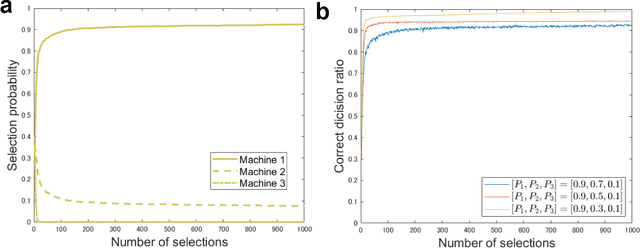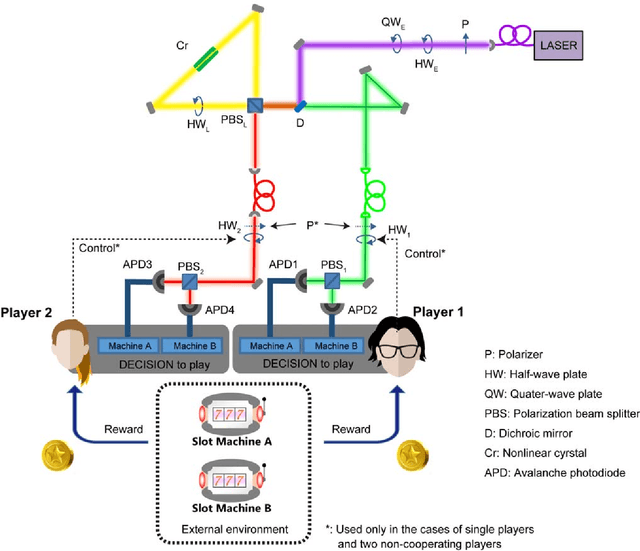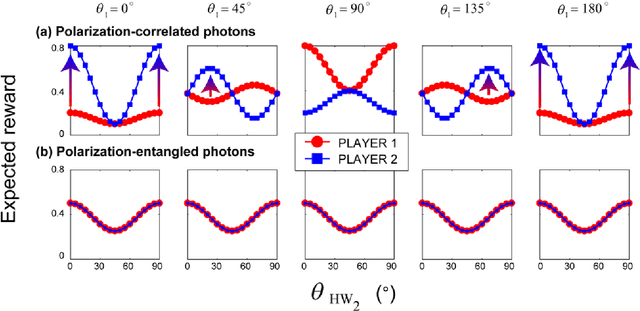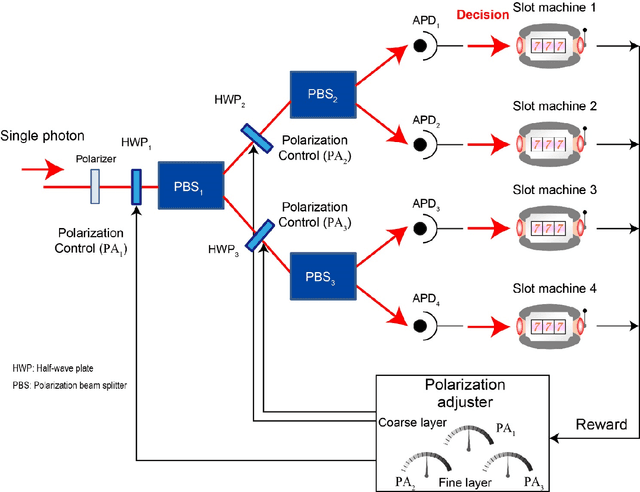Serge Huant
Conflict-free collective stochastic decision making by orbital angular momentum entangled photons
Jul 02, 2021



Abstract:In recent cross-disciplinary studies involving both optics and computing, single-photon-based decision-making has been demonstrated by utilizing the wave-particle duality of light to solve multi-armed bandit problems. Furthermore, entangled-photon-based decision-making has managed to solve a competitive multi-armed bandit problem in such a way that conflicts of decisions among players are avoided while ensuring equality. However, as these studies are based on the polarization of light, the number of available choices is limited to two, corresponding to two orthogonal polarization states. Here we propose a scalable principle to solve competitive decision-making situations by using the orbital angular momentum as the tunable degree of freedom of photons, which theoretically allows an unlimited number of arms. Moreover, by extending the Hong-Ou-Mandel effect to more than two states, we theoretically establish an experimental configuration able to generate entangled photon states with orbital angular momentum and conditions that provide conflict-free selections at every turn. We numerically examine total rewards regarding three-armed bandit problems, for which the proposed strategy accomplishes almost the theoretical maximum, which is greater than a conventional mixed strategy intending to realize Nash equilibrium. This is thanks to the entanglement property that achieves no-conflict selections, even in the exploring phase to find the best arms.
Category Theoretic Analysis of Photon-based Decision Making
May 09, 2018Abstract:Decision making is a vital function in this age of machine learning and artificial intelligence, yet its physical realization and theoretical fundamentals are still not completely understood. In our former study, we demonstrated that single-photons can be used to make decisions in uncertain, dynamically changing environments. The two-armed bandit problem was successfully solved using the dual probabilistic and particle attributes of single photons. In this study, we present a category theoretic modeling and analysis of single-photon-based decision making, including a quantitative analysis that is in agreement with the experimental results. A category theoretic model reveals the complex interdependencies of subject matter entities in a simplified manner, even in dynamically changing environments. In particular, the octahedral and braid structures in triangulated categories provide a better understanding and quantitative metrics of the underlying mechanisms of a single-photon decision maker. This study provides both insight and a foundation for analyzing more complex and uncertain problems, to further machine learning and artificial intelligence.
Entangled photons for competitive multi-armed bandit problem: achievement of maximum social reward, equality, and deception prevention
Apr 12, 2018



Abstract:The competitive multi-armed bandit (CMAB) problem is related to social issues such as maximizing total social benefits while preserving equality among individuals by overcoming conflicts between individual decisions, which could seriously decrease social benefits. The study described herein provides experimental evidence that entangled photons physically resolve the CMAB, maximizing the social rewards while ensuring equality. Moreover, by exploiting the requirement that entangled photons share a common polarization basis, we demonstrated that deception, or delaying the other player receiving a greater reward, cannot be accomplished in a polarization-entangled-photon-based system, while deception is achievable in systems based on classical or polarization-correlated photons. Autonomous alignment schemes for polarization bases were also experimentally demonstrated based on decision conflict information. This study provides the foundation for collective decision making based on polarization-entangled photons and their polarization and value alignment, which is essential for utilizing quantum light for intelligent functionalities.
Single photon in hierarchical architecture for physical reinforcement learning: Photon intelligence
Sep 01, 2016



Abstract:Understanding and using natural processes for intelligent functionalities, referred to as natural intelligence, has recently attracted interest from a variety of fields, including post-silicon computing for artificial intelligence and decision making in the behavioural sciences. In a past study, we successfully used the wave-particle duality of single photons to solve the two-armed bandit problem, which constitutes the foundation of reinforcement learning and decision making. In this study, we propose and confirm a hierarchical architecture for single-photon-based reinforcement learning and decision making that verifies the scalability of the principle. Specifically, the four-armed bandit problem is solved given zero prior knowledge in a two-layer hierarchical architecture, where polarization is autonomously adapted in order to effect adequate decision making using single-photon measurements. In the hierarchical structure, the notion of layer-dependent decisions emerges. The optimal solutions in the coarse layer and in the fine layer, however, conflict with each other in some contradictive problems. We show that while what we call a tournament strategy resolves such contradictions, the probabilistic nature of single photons allows for the direct location of the optimal solution even for contradictive problems, hence manifesting the exploration ability of single photons. This study provides insights into photon intelligence in hierarchical architectures for future artificial intelligence as well as the potential of natural processes for intelligent functionalities.
 Add to Chrome
Add to Chrome Add to Firefox
Add to Firefox Add to Edge
Add to Edge